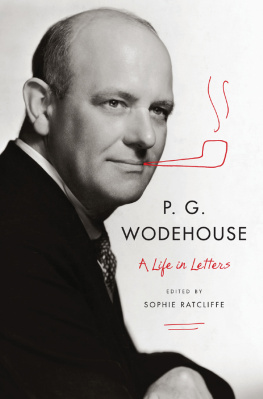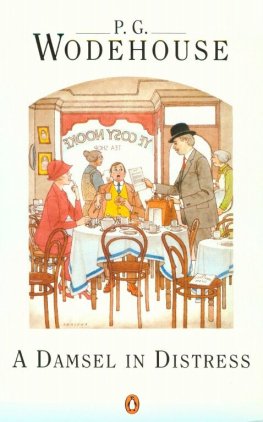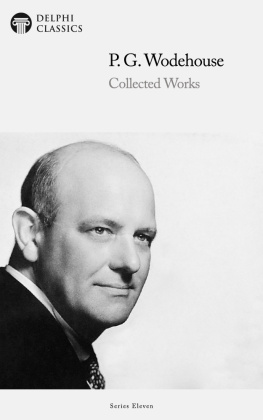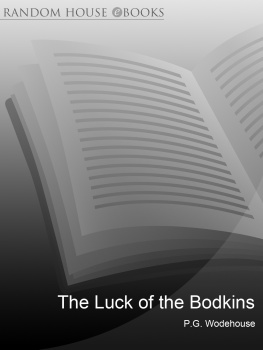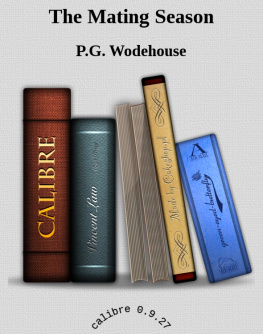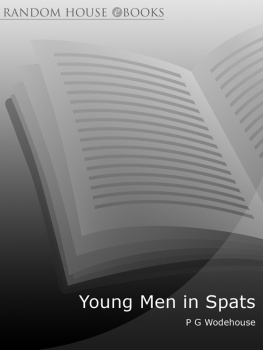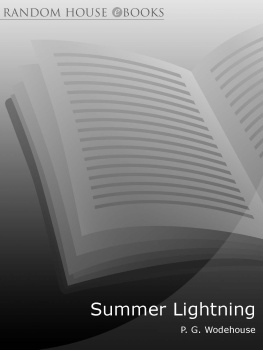P. G . WODEHOUSE
PLATES
Section One
Section Two
ILLUSTRATIONS IN THE TEXT
The editor and publisher are grateful to the following for permission to reproduce photographs: plates 2, 3, 17, 24, 27, 28, 30, 36, and p. 70, p. 299, p. 300, Wodehouse Estate; plate 6, courtesy of HSBC holdings plc; plates 7, 11, 12, 18, 20, 26, 34 and pages 33, 55, 69, 95, 130, 300, courtesy of Tony Ring; plate 8, image courtesy of Mellors and Kirk Fine Art Auctioneers; plate 9, courtesy of N. T. P. Murphy; plate 10, courtesy of Richard Perceval-Maxwell; plate 13, by kind permission of Emsworth Maritime and Historical Trust (Emsworth Museum); plate 14, courtesy of Timothy Bradshaw; plate 15, courtesy of Ann Garland and Linda Eaton; plate 16, Source: Library and Archives Canada/Department of Employment and Immigration fonds/RG 76, Microfilm T-4790; plate 21, National Portrait Gallery, London; plate 22, courtesy of Tatler ; plate 23, Sasha/Hulton Archives/Getty Images; plate 25, Popperfoto/Getty Images; plate 31, National Archives; plate 32, courtesy of Reinhild von Bodenhausen ; plate 33, The Advertising Archive ; page 42, The Morgan Library and Museum, New York; pages 45, 48 and 186, with kind permission of the Governors of Dulwich College; page 67, The Bodleian Library, Oxford; page 70, Henry W. and Albert A. Berg Collection of English and American Literature, The New York Public Library, Astor, Lenox and Tilden Foundations; pages 293 and 299, Columbia University Library. Every effort has been made to contact all copyright holders. If notified, the publisher will be pleased to rectify any errors or omissions at the earliest opportunity.
When it comes to letter-writing, P. G. Wodehouses Bertie Wooster belongs to the minimalist school:
Dear Freddie,
Well, here I am in New York. Its not a bad place. Im not having a bad time. Everythings not bad. The cabarets arent bad. Dont know when I shall be back. Hows everybody? Cheerio!
Yours,
Bertie.
PS. Seen old Ted lately?
Not that I cared about old Ted, he adds, but if I hadnt dragged him in I couldnt have got the confounded thing on to the second page. 1
Receiving post is, for Bertie, equally confounding. This is partly a matter of timing; morning, after all, is never the best time for reading, especially if you have a bit of a head on.2 But it is also because the letter, in the world of Wodehouse, is an intrusive presence a symbol of reality permeating the all-too-secure haven of ones bachelor flat, gentlemens club or country seat. Whether it hails from an aunt, fiance or amorous peer of the realm, the envelope by the toast rack is a threatening sight a crumb in the butter of the Wodehousean Eden.
Wodehouses own attitude to letters was more positive. Many different exchanges ranging from notes to his family to business letters and discussions of plot design offer a fascinating and unique insight into a twentieth-century writing life, and the history of his time. Wodehouse exchanged letters with numerous well-known figures including artists and writers such as Ira Gershwin, Evelyn Waugh, George Orwell and Agatha Christie. He also kept up a regular correspondence with his friends and family, especially his beloved step-daughter, Leonora, or Snorky.
While some might assume that Wodehouses novels are conventional, beneath the mostly male upper-crust there is some radical table-turning. Butlers bail their masters out, passion wins over reason, and girls, invariably, know more than boys. The letters reveal the roots of this reversal. Wodehouse was a self-made man who married a chorus-girl, spent time with Hollywood movie stars, and endured Nazi imprisonment and journalistic accusations of treason. This was a life that was much more eventful than many especially many of his younger generations of readers might assume. As for the man himself, this laureate of repression could be affectionate, naughty and tender in correspondence.3
A number of these letters touch on Wodehouses feelings about love. Bertie Wooster declares that there are two sorts of men. Those who would like to find a woman in their bedroom, and those who would rather not. From accounts of his own marriage, Wodehouse was, in many ways, of the second sort. Nevertheless, his early letters to his friend Leslie Bradshaw contain some revealing details about his romantic encounters, while in his later letters he speculates, from time to time, on other peoples sex lives, marriages and divorces.
Solvency is also a key theme of his correspondence the getting, losing and spending of money dominates his letters as much as it does his plots. Ever since missing out on his place at Oxford, Wodehouse was driven by the idea of bringing in the boodle and he was hugely successful as an earner.4 The correspondence follows his financial fortunes, his crises with the taxman, his affectionate reflections on his wifes spending, and his gifts to friends and family.
Elsewhere, letters demonstrate the difficulties of plotting, the complexities of character creation and also the moments of inspiration. When Jeeves, the perfect omniscient nanny, first entered the Wodehouse oeuvre, he came in with the utmost discretion.5 As Wodehouse told Lawrence Durrell, [i]t never occurred to me that Jeeves would do anything except open doors and announce people.6
Whether delivering an account of the difficulties of getting a small glass of whiskey during Prohibition, or giving the low down on the Riviera,7 Wodehouse offers characteristically comic accounts of living, writing and socialising in England, America and France through the 1920s and 1930s as well as an extraordinary account of his life in a German internment camp, in Nazi Berlin, and in occupied and post-liberation Paris.
Given Wodehouses acknowledged skill as a novelist, it is perhaps surprising that it has taken so long for so many of these letters to be collected in one volume.8 The delay comes in part from Wodehouses unusual place in the English canon. An acknowledged master of the English comic novel, praised by philosophers such as Ludwig Wittgenstein and Anthony Quinton, and writers such as T. S. Eliot and W. H. Auden, he has also always been an unashamedly popular writer one whom readers have, on the whole, simply enjoyed, rather than studied. From one perspective, Wodehouse merits a scholarly volume, directed at an academic audience from another, he deserves a letters book aimed at the general reader. This edition seeks to serve both readerships.
Wodehouse is also a writer whose works resist a certain sort of biographical approach. He disliked investigations into his personal life and circumstances, partly because he found them intrusive. (He wrote to his friend William Townend that their unedited correspondence should eventually be destroyed. Gosh, he added, it would be awful if some of the things Ive written you were made public).9 And he also intimated that biographical context was, to a degree, irrelevant to understanding a work of art. Writing about Shakespeare, he noted that a thing I can never understand is why all the critics seem to assume that his plays are a reflection of his personal moods and dictated by the circumstances of his private life. You know the sort of thing I mean. They say Timon of Athens is a gloomy bit of work. That means that Shakespeare was having a lousy time when he wrote it. I cant see it. Do you find that your private life affects your work? I dont.10
Indeed, while the Edwardian England of Wodehouses early adulthood permeates his works, his personal circumstances and the tenor of his fictional worlds are not always an easy match. One of the surprises of this correspondence is the occasional, startling disparity between life and art. Take his masterly Joy in the Morning , written during one of the most difficult periods of his life. Just weeks after leaving Nazi internment, Wodehouse was still able to conjure up the embowered hamlet of Steeple Bumpleigh, in the midst of smiling fields and leafy woods. While he struggled with the weight of national disapproval, his halcyon fictional world had only one cloud on the horizon the somewhat sticky affair of Bertie, Florence Craye and Stilton Cheesewright effortlessly resolved by the shimmering Jeeves.11

